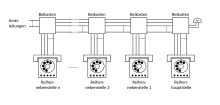Serial system
The series system ( RAnl ) was an embodiment of a telephone system at the Deutsche Bundespost . While in the telephone systems with switching equipment extensions converge in star configuration to the telephone system, all the lines phones mentioned at all "series extension" were added sequentially performed at key systems and ended in "row major site".
Technical design
In the case of row systems there was no automatic switching device, the trunk lines run through all authorized row extensions and end at the "row main unit". From a technical point of view, the main line unit was a line extension unit like the others, but it was responsible for signaling incoming calls. The trunk lines and all extension lines were routed through all extension extensions and ended in the main extension. Discussions within the series system were handled via the extension lines. With the help of buttons, each extension could connect to each of the passing exchange and extension lines and establish connections itself. For this purpose, each extension was connected to every other extension with a line. Because of the parallel connection of the series extensions, high-pair telephone cables were required between the telephones . Therefore, row systems were only suitable if the individual call stations were close to one another. The number of cores in the cables to be laid was dependent on the number of microphone units, the maximum configuration and the make. The number of cores was between 17 cores for small and 120 cores for large series systems. The telephones were connected to "additional boxes". In the side boxes, the installation cables were placed on terminal strips. The power supply unit and any additional equipment such as the listening device and charge indicator were also installed in the additional box of the row main unit .
Official traffic
To establish an outgoing exchange connection, the exchange key of a free exchange line was pressed. Incoming calls were signaled at the main line with an alarm clock and a call lamp in the exchange key . However, the call could be answered on any authorized telephone by picking up the telephone receiver and pressing the illuminated exchange key. The caller could then be put through to the desired extension number if necessary.
Internal traffic
The corresponding indoor connection button was pressed to establish a connection to another chain extension. The buzzer then sounded at the serial extension called. In the case of row systems, the internal communication was not secret.
Overview of the row systems
| Designation (version) | Trunks | In-line extensions | Number of wires (at least) between the row extensions |
|---|---|---|---|
| RAnl 202 (1/2) | 1 | 2 | 17th |
| RAnl 203 (1/2) | 1 | 2 | 21st |
| RAnl 212 (1/5) | 1 | 5 | 32 |
| RAnl 213 (1/5) | 1 | 5 | 24 |
| RAnl 234 (2/5) | 2 | 5 | 48 |
| RAnl 243 (4/10) | 4th | 10 | 120 |
Individual evidence
- ↑ Handbook of Telecommunications Technology, Basic Series Volume 6, Telephones, Telephony Suppression, PBXs, as of spring 1976, p. 123
- ↑ a b Helmut Kopf: Telephony Suppression , Series Vocational Training for Telecommunication Craftsman Volume 5, Kohl + Noltemeyer Verlag, 1984, p. 96
- ↑ a b c Kurt Hantsche: Pocket book of telephone extension systems , Verlag R. Oldenburg, 2nd edition 1964, p. 78
